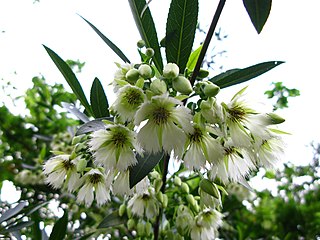
Elaeocarpus is a genus of nearly five hundred species of flowering plants in the family Elaeocarpaceae native to the Western Indian Ocean, Tropical and Subtropical Asia, and the Pacific. Plants in the genus Elaeocarpus are trees or shrubs with simple leaves, flowers with four or five petals usually, and usually blue fruit.

Tritaxis is a genus of plants under the family Euphorbiaceae first described as a genus in 1858. It is native to Southeast Asia, including parts of India, Sri Lanka, China Hainan, else into Philippines New Guinea, and Northern Australia (Queensland). Until recently, many species were listed under the genus Dimorphocalyx, first described as a genus several years later in 1861.

Cleistanthus is a plant genus of the family Phyllanthaceae, tribe Bridelieae, first described as a genus in 1848. It is widespread in much of the Old World Tropics in Asia, Africa, Australia, and various oceanic islands. Cleistanthus collinus is known for being toxic and may be the agent of homicides or suicides.
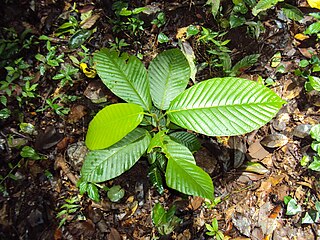
Dipterocarpus is a genus of flowering plants and the type genus of family Dipterocarpaceae.

Robert Wight was a Scottish surgeon in the East India Company, whose professional career was spent entirely in southern India, where his greatest achievements were in botany – as an economic botanist and leading taxonomist in south India. He contributed to the introduction of American cotton. As a taxonomist he described 110 new genera and 1267 new species of flowering plants. He employed Indian botanical artists to illustrate many plants collected by himself and Indian collectors he trained. Some of these illustrations were published by William Hooker in Britain, but from 1838 he published a series of illustrated works in Madras including the uncoloured, six-volume Icones Plantarum Indiae Orientalis (1838–53) and two hand-coloured, two-volume works, the Illustrations of Indian Botany (1838–50) and Spicilegium Neilgherrense (1845–51). By the time he retired from India in 1853 he had published 2464 illustrations of Indian plants. The standard author abbreviation Wight is used to indicate this person as the author when citing a botanical name.

Actinodaphne is an Asian genus of flowering plants in the laurel family (Lauraceae). It contains approximately 125 species of dioecious evergreen trees and shrubs.
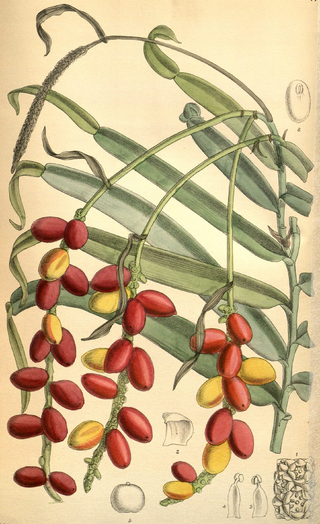
Pothos is a genus of flowering plants in the family Araceae. It is native to China, the Indian Subcontinent, Australia, New Guinea, Southeast Asia, and various islands of the Pacific and Indian Oceans.

Millettia is a genus of flowering plants in the family Fabaceae. It consists of about 169 species of shrubs, lianas or trees, which are native to tropical and subtropical regions of sub-Saharan Africa, the Indian subcontinent, Indochina, southern China, Malesia, and New Guinea. Typical habitats include tropical rain forest and seasonally-dry lowland and upland forest and forest margins, woodland, thicket, wooded grassland, and secondary vegetation.

Alseodaphne is a genus of plants in the family Lauraceae, endemic to China and Southeast Asia. The genus has 96 species of evergreen trees to shrubs. They have bisexual flowers, a fruit stalk that is red, green, or yellow, and black fruit.

Montague Dundas Cockburn was a Scottish coffee planter, and Collector of Salem district between 1820 and 1829. He was the father of ornithologist and painter Margaret Cockburn.
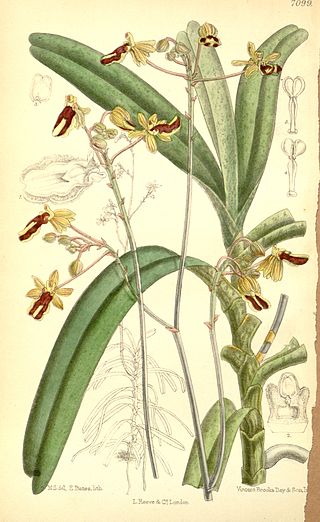
Cottonia is a monotypic genus of flowering plants from the orchid family, Orchidaceae: the only known species is Cottonia peduncularis. It is native to India and Sri Lanka. The genus was erected by Robert Wight and named after Major Frederick Cotton, an amateur botanist who served in the Madras Engineer Group and collected the species from Tellichery. A coloured illustration of the plant had been sent to Wight by Thomas C. Jerdon.

Cleghornia is a genus of plants in the family Apocynaceae. It includes two species, which are native to Borneo, China, Laos, Malaysia, Sri Lanka, Thailand, and Vietnam.
Diospyros ovalifolia, known as bastard ebony, is a tree in the family, Ebenaceae, endemic to the leeward side of South Sahyadri of Western Ghats of India and Sri Lanka.
Isonandra lanceolata is a plant in the family Sapotaceae. The specific epithet lanceolata means 'spear-shaped', referring to the leaves.
Isonandra montana is a plant species first described in 1860.

Nothosaerva is a monotypic genus of flowering plants in the family Amaranthaceae containing the single species Nothosaerva brachiata. It is native to India, Sri Lanka, Southeast Asia, and eastern Africa.

Impatiens jerdoniae is a species of flowering plant in the family Balsaminaceae. It is native to the Western Ghats of India. It was described and named by Robert Wight and commemorates Flora Jerdon, wife of Thomas C. Jerdon. It grows on rocks and as an epiphyte on trees.
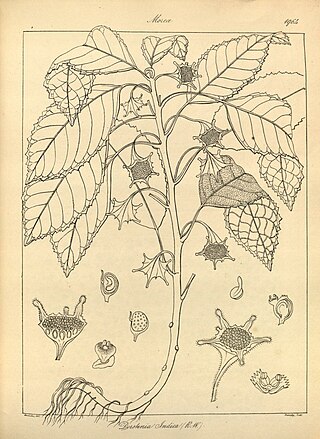
Dorstenia indica is a small plant species in the family Moraceae native to Southern India and Sri Lanka. It was first described by Robert Wight in 1853.

Rungiah aka Rungia or Rungia Raju was a 19th-century Indian botanical illustrator, noted for producing a large number of images for Robert Wight's books on Indian flora. The Raju family were painters of the Kshatriya caste of Tanjore, and were originally from the Telugu-speaking region in the state of Andhra Pradesh.

Acrotrema is a genus of flowering plants in the family Dilleniaceae. It is found in South Asia in India, Malaysia, Myanmar, Sri Lanka, and Thailand.

















